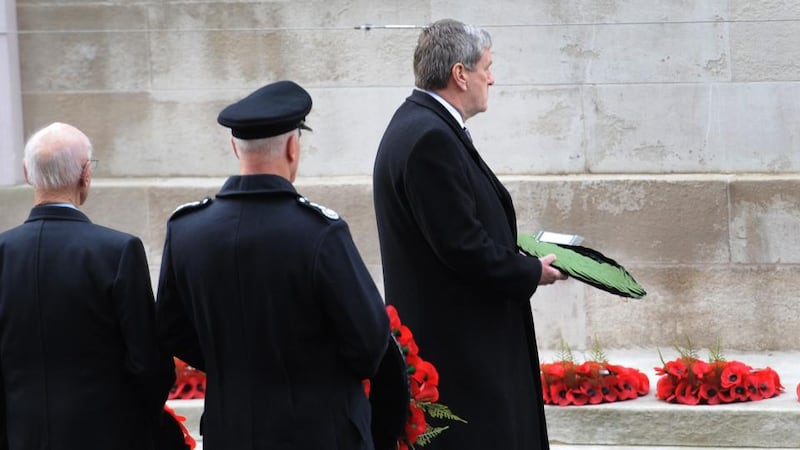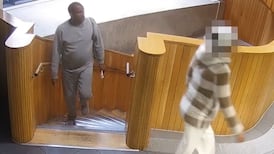Everything about the Remembrance Sunday commemorations at the Cenotaph in Whitehall in London are minutely planned, down to the positioning of dignitaries or the last footstep of a brightly arrayed bandsman.
So too was the planning surrounding the laying of a wreath by Ireland's Ambassador to Britain, Dan Mulhall – the first time Ireland has been represented since the declaration of the Republic in 1949.
Seconds after 10.53am, Mulhall emerged from the Foreign Office holding a laurel wreath and followed by a line of Commonwealth ambassadors – each of whom held the traditional red poppy wreath.

However, the Irish presence was not just diplomatic. Minutes earlier, the band of the foot guards had opened proceedings with a series of tunes, including two Thomas Moore compositions, Oft in the Stilly Night and The Minstrel Boy.
The Cenotaph ceremony, which was first held on Armistice Day in 1919 a year after the guns fell silent, was particularly poignant this year as it marked the 100th anniversary of the start of the first World War.
On the first stroke of Big Ben at 11am, the crowds lining the streets fell silent, the only sounds heard being the occasional call of a gull or the whirr of a photographer’s camera, before the two minutes of silence drew to a close.
Royal family
From 11.03am, Queen Elizabeth placed a largewreath at the centre of the top step on the north side of the Cenotaph, followed moments later by the Duke of Edinburgh, Prince Philip, and other members of the royal family.
They were followed by prime minister David Cameron, deputy prime minister Nick Clegg and Labour Party leader Ed Miliband, who bowed his head for moments longer than the others.
Democratic Unionist Party MP Nigel Dodds moved to lay his wreath, followed by a Plaid Cymru MP and the British foreign secretary Philip Hammond, before it was the turn of the diplomats.
The London-based high commissioners from the Commonwealth came forwards in three groups to place their tributes to the fallen before it was Ambassador Mulhall’s turn to lay a laurel wreath.
Leading prayers, the Church of England Bishop of London Richard Chartres asked the Lord for help "to serve thee as thou deservest; to give and not to count the cost; to fight and not to count the wounds; to toil and not seek for rest".
Irish tribute
Mulhall’s solo tribute was agreed with the British authorities beforehand to publicly reflect the importance of Ireland’s return to the Cenotaph commemorations, but also to take into account that it is not part of the Commonwealth.
Following the foundation of the Free State in 1922, Ireland was represented at governor-general, or high commissioner rank between then and 1938 and again, in 1945 and 1946, despite the souring of relations between Winston Churchill and Éamon de Valera.
Speaking later Mulhall said: “I was honoured, frankly, to be the first Irish Ambassador to lay a wreath here. I think it is a natural extension of the Taoiseach’s presence at Enniskillen and the Minister for Foreign Affairs’ in Belfast.
"It reflects the desire we have to remember the Irish men who died in the first World War, but it also reflects the relations that now exist between the two countries," he told The Irish Times.
Ireland has been edging towards a presence at the Cenotaph for some time. Last year Mulhall – and before him his predecessor, Bobby McDonagh – attended as observers but not in a public role.
Saying that it is right that "shared sacrifice" should be remembered, secretary of state for culture Sajid Javid said Irish servicemen had "stood side by side with men and women from across Great Britain and the Commonwealth" throughout the first World War.
The Irish Government had been invited "to lay a wreath at this and future years' Remembrance Sunday ceremonies" in recognition of the immense contribution made by so many. "It is right we remember," he said.
Closer bonds
More than 200,000 Irishmenvolunteered to serve in the
British Army
in the conflict. Of those, 35,000 were killed during the war itself, while 15,000 more succumbed later to wounds received.
Yesterday’s ceremony is the latest occasion when Ireland and the UK have joined together to commemorate those lost in the war, following the unveiling of a memorial in Glasnevin Cemetery to honour Ireland’s Victoria Cross holders.












